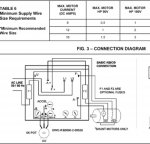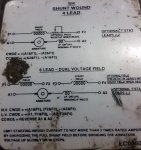202025-1415 EDT
You need to understand the basics of a DC motor.
A basic DC motor consists of a magnetic field that is fixed in space, of constant magnitude, and does not rotate in space. This produces a constant magnetic field fixed in position in space. In a wound field vs a permanent magnet motor the current to the field can can be changed so the field magnetic intensity can be changed. This means I am talking about an original type DC motor, not a DC brushless which is really a synchronous AC motor. A basic DC motor will have an armature with a number of coils wound on an armature that is mounted on bearings to allow rotation, and the armature coils are connected to a commutator that provides a synchronous switch via fixed brushes. The fixed magnetic field interacts with the armature field to produce a force that produces a torque to rotate the motor.
Because of armature rotation there is also a voltage induced in the armature coil. This induced voltage is in opposition to the voltage applied to the armature, and is called counter EMF. This counter EMF is directly proportional to armature speed, RPM. In an ideal motor, no losses of any kind, this counter EMF would exactly equal the applied armature voltage.
Thus, for a fixed field intensity, constant current to the field, the motor RPM is directly proportional to the applied armature voltage.
Now, if you reduce the fixed field intensity to 1/2 its previous value (1/2 the current), then the armature has to rotate 2 times as fast to produce the same counter EMF. Any good shunt wound DC motor control circuit must have a loss of field excitation circuit to cut armature power on loss of field current. In our DC machinery labs one person in the group was assigned the task of being that field monitor. Typically we worked with 5 HP motors, and if one ran away it could fly apart and kill someone.
In a test machine that was used to test Dana transfer cases for the Ford Aerostar I supplied the testing gear, and I had to interact with 3 50 HP shunt wound motors. These were GE motors with blowers so full torque could be supplied at zero RPM. The motor controls were equipped with loss of field detection. With full field excitation maximum RPM was about 2000. By reducing the field during part of the machine cycle we could increase RPM to 3000, but at reduced torque.
This transfer case had three shafts, a differential, a locking clutch, and means to detect differential speed between front and rear drive shafts. If angular difference between front and rear was excessive, then the clutch was engaged making it a solid transfer case. A very effective automatic transfer case. In normal operation torque to the rear was about 65%, and front 35%, but the front and rear wheels did not have rotate at precisely the same speed. When locked up the torque balance was road determined. On a wet pavement with plastic marking strips I could accelerate across these with no apparent slip. That was the speed of the automatic lock up. An ordinary solid transfer case forces both front and rear to be exactly the same speed. That results in tire slip on dry pavement, tire wear.
.





